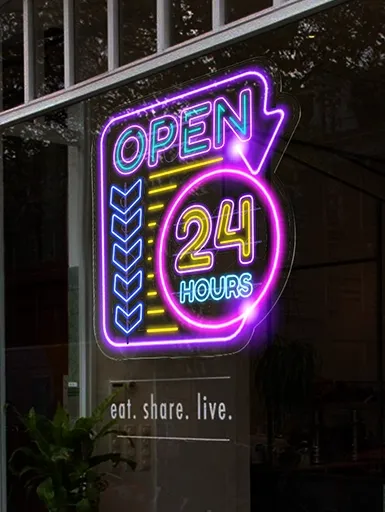
Introduction
Neon signs have been a popular form of advertising and decoration for decades. The bright, vibrant glow of neon lights can grab attention and create a unique atmosphere that is not easily replicated. If you have ever been fascinated by these mesmerizing signs and have considered making your own, you have come to the right place. In this ultimate guide, we will explore the process of custom neon sign making, from materials and tools to installation and starting your own neon sign business. Whether you are a hobbyist or an aspiring entrepreneur, this guide will provide you with the knowledge and inspiration you need to get started.
Neon Sign Materials
Before diving into the exciting process of creating a custom neon sign, it is important to familiarize yourself with the materials required. Here are the essential components you will need:
Glass Tubes: The most crucial element of a neon sign is the glass tube. These tubes are available in various shapes and sizes, and they are the foundation of your design. It is important to choose high-quality glass tubes to ensure the longevity and reliability of your finished sign.

Electrodes: Electrodes are the metal caps that seal the ends of the glass tubes and hold the neon or argon gas inside. These electrodes are connected to electrical wires, which allow the neon sign to light up.
Gas: Neon signs are typically filled with either neon gas or argon gas, depending on the desired color and effect. Neon gas produces a warm red-orange glow, while argon gas emits a trendy blue light. In some cases, a combination of the two gases may be used to produce different colors.
Transformer and Power Supply: Neon signs require a transformer and power supply to convert the standard electrical current into the high-voltage needed to light up the sign. It is important to choose a transformer that matches the specifications of your neon sign.
Electrode Covers: To protect the electrodes and wires, electrode covers are used. These covers are typically made of ceramic or silicone and help prevent damage and ensure the proper functioning of the sign.
Backing Material: The backing material provides support for the neon tubes and holds them in place. Common backing materials include clear acrylic, metal frames, or custom shapes made from wood or acrylic.
Additional Materials: Other materials needed for custom neon sign making include electrode supports, electrical wire, insulating tape, mounting hardware, and safety equipment such as gloves and goggles.
Neon Sign Installation
Once you have created your custom neon sign, it's time to install it. The installation process will depend on the type of sign and the location where it will be displayed. Here are some key steps to consider:
Planning and Designing: Before installation, carefully plan the placement of your neon sign. Consider factors such as visibility, lighting conditions, and any necessary permits or permissions. Create a detailed design and layout to guide you during the installation process.
Mounting the Sign: Start by securing the backing material to the desired surface. Depending on the weight and size of the sign, different mounting methods can be used, such as brackets, screws, or adhesive tapes. Make sure the sign is level and secure to avoid any potential accidents.

Connecting the Power Supply: Carefully connect the power supply and transformer to the neon sign electrodes. Follow the manufacturer's instructions and ensure the electrical connections are secure and protected. Safety should always be a priority during the installation process.
Testing and Adjustments: Once the sign is installed and connected, test it to ensure all the components are functioning correctly. Make any necessary adjustments to the electrodes or gas levels to achieve the desired brightness and color. Double-check for any potential electrical or safety issues before leaving the sign unattended.
Maintenance and Care: Regularly inspect and maintain your neon sign to keep it in optimal condition. Clean the glass tubes and backing material to remove any dust or dirt that may affect the visibility of the sign. Consider scheduling routine maintenance checks to detect and address any potential issues before they become significant problems.
Neon Sign Business
If you have a passion for neon sign making, you may consider turning it into a profitable business venture. Here are some key aspects to consider if you want to start your own neon sign business:
Market Research: Conduct thorough market research to identify potential customers and competitors in your area. Determine the demand for custom neon signs and assess the pricing strategies of existing businesses. This information will help you develop a unique selling proposition and target your marketing efforts effectively.
Business Plan: Create a detailed business plan that outlines your goals, target market, financial projections, marketing strategies, and operational procedures. Consider factors such as the cost of materials, equipment, labor, and overhead expenses. A well-thought-out business plan is essential for securing funding and guiding your business's growth.
Workspace and Equipment: Set up a dedicated workspace for your neon sign making operations. Ensure you have adequate space, proper ventilation, and the necessary equipment and tools. Depending on your business's scale, this may include glass-blowing torches, gas supply systems, bending equipment, and safety gear.
Building a Portfolio: Develop a portfolio showcasing your best neon sign designs and projects. Display your portfolio on a website or in a physical showroom to attract potential customers and demonstrate your skills and creativity. Consider offering customization options and personalized designs to cater to a wide range of client preferences.
Marketing and Branding: Implement effective marketing strategies to raise awareness about your neon sign business. Utilize social media platforms, online directories, and local advertising channels to reach your target audience. Develop a strong brand identity that reflects your business's unique style and values.
Customer Service: Provide excellent customer service to build a loyal customer base and generate positive word-of-mouth. Respond promptly to inquiries, offer personalized recommendations, and ensure timely delivery and installation. Happy customers are more likely to recommend your services and contribute to the growth of your business.
Continuous Learning: Stay updated with the latest trends and technologies in the neon sign industry. Attend workshops, conferences, and trade shows to expand your knowledge and network with fellow professionals. Embrace innovation and constantly strive to improve your craft to stay ahead of the competition.
Conclusion
Custom neon sign making is an exciting and rewarding craft that allows you to unleash your creativity and bring unique designs to life. From selecting the right materials to mastering the installation process and starting your own neon sign business, this ultimate guide has provided you with valuable insights and steps to embark on your neon sign making journey. Remember to prioritize safety, quality, and customer satisfaction throughout the process, and let your imagination shine bright through your stunning custom neon signs. Happy sign making!


























